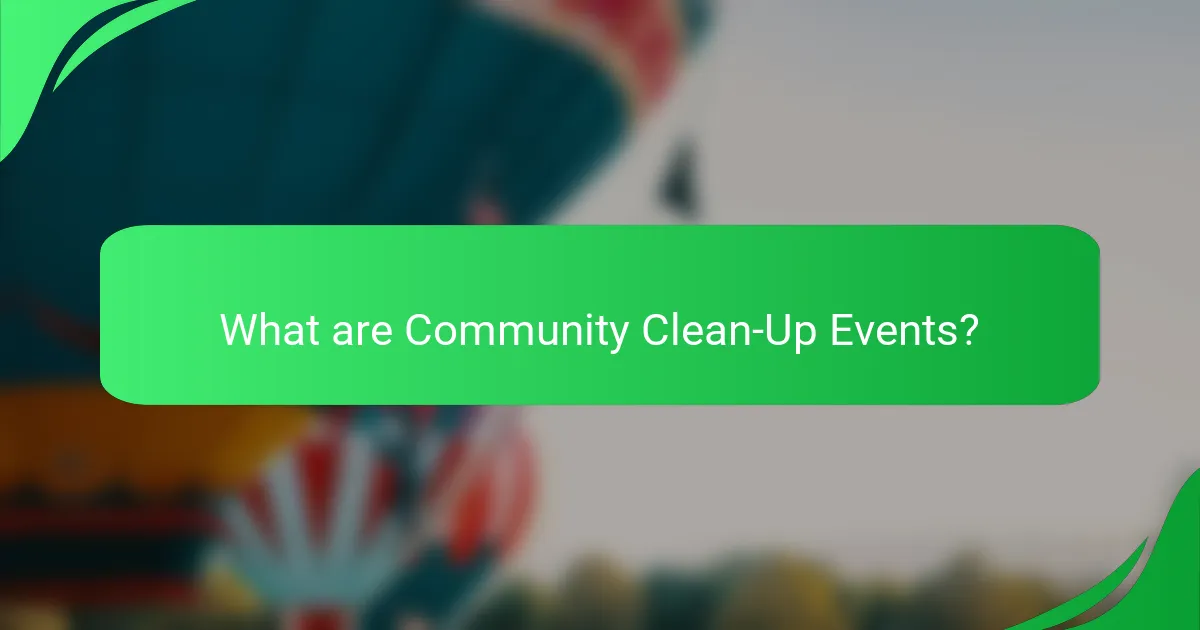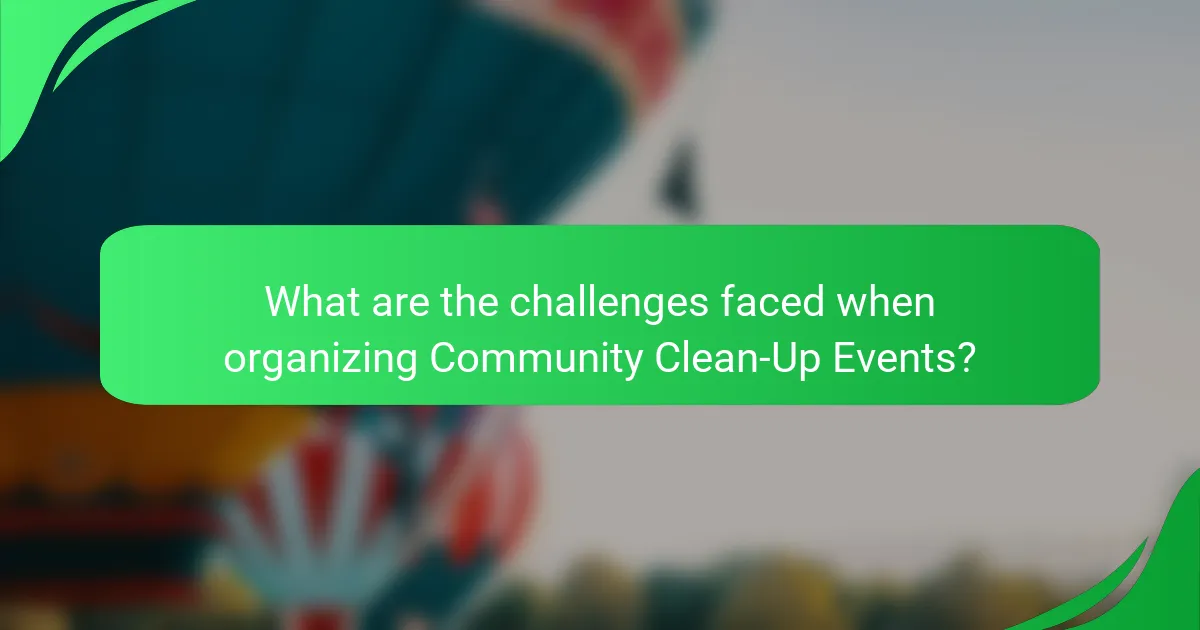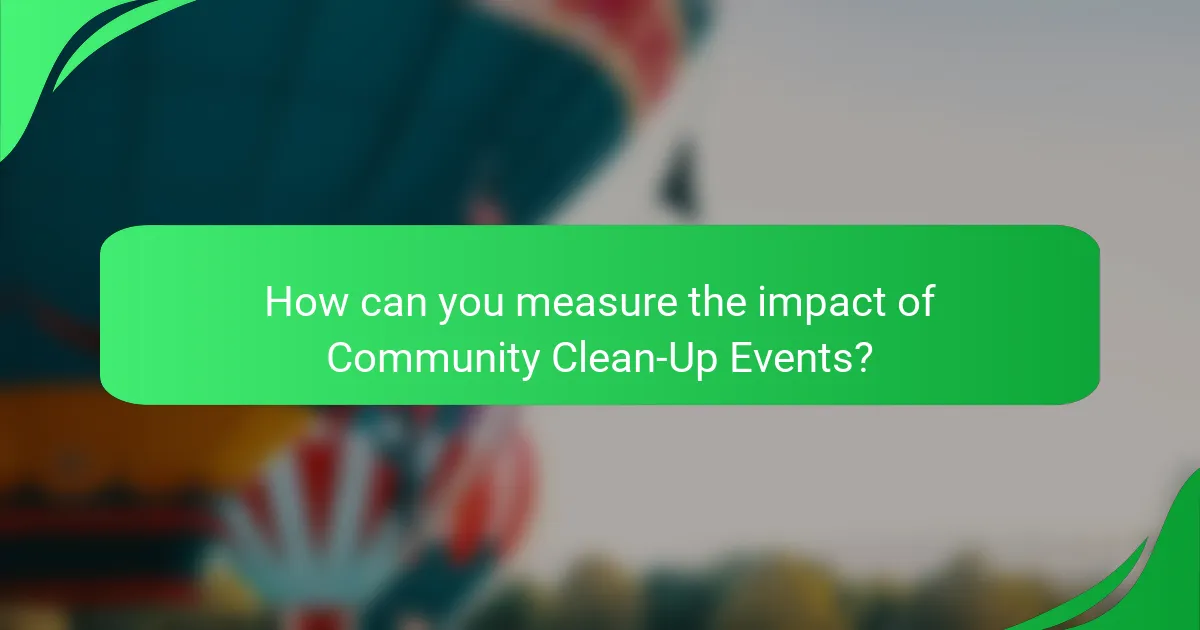Community clean-up events are organized activities designed to enhance public spaces such as parks, streets, and beaches through volunteer participation. These events not only promote civic responsibility and community spirit but also contribute to environmental improvement by reducing pollution. The article outlines essential planning steps for organizing these events, discusses the community benefits they provide, and highlights effective methods for measuring their impact. Key challenges faced during organization include securing participation, obtaining permits, and managing logistics, all of which require careful planning and community involvement. Additionally, the article emphasizes both quantitative and qualitative metrics for assessing the success and lasting effects of clean-up efforts.

What are Community Clean-Up Events?
Community clean-up events are organized activities where individuals come together to clean and beautify public spaces. These events typically focus on areas like parks, streets, and beaches. Participants often pick up litter, plant flowers, or perform landscaping tasks. Community clean-up events foster community spirit and encourage civic responsibility. They can also improve local environments by reducing pollution. According to Keep America Beautiful, such initiatives can lead to a 50% reduction in litter in participating areas. These events often involve local organizations, schools, and volunteers, promoting collaboration and engagement.
How do Community Clean-Up Events benefit local communities?
Community clean-up events benefit local communities by improving environmental conditions and fostering community engagement. These events lead to cleaner public spaces, which enhances the overall aesthetic and health of the area. Cleaner environments can reduce pollution and improve local wildlife habitats. Additionally, participation in clean-up efforts builds a sense of community pride and encourages residents to take ownership of their surroundings. Studies show that neighborhoods with active clean-up initiatives often experience lower crime rates and increased social cohesion. Engaging in these events can also provide educational opportunities about sustainability and responsible waste management.
What are the environmental impacts of Community Clean-Up Events?
Community Clean-Up Events positively impact the environment by reducing litter, improving local ecosystems, and fostering community engagement. These events remove trash from parks, streets, and waterways, decreasing pollution levels. A study by the Environmental Protection Agency found that litter can harm wildlife and degrade habitats. By participating in clean-ups, volunteers help restore natural areas, promoting biodiversity. Additionally, these events raise awareness about environmental issues. They encourage sustainable practices among community members. Enhanced community pride and responsibility often result from these collective efforts. Overall, Community Clean-Up Events contribute to a cleaner, healthier environment.
How do these events foster community engagement?
Community clean-up events foster community engagement by bringing residents together for a common purpose. Participants collaborate to improve their environment, which strengthens social bonds. These events create opportunities for dialogue and networking among community members. They also raise awareness about local issues, encouraging collective action. Research indicates that community involvement increases civic pride and responsibility. According to a study by the National Recreation and Park Association, 75% of participants felt more connected to their community after engaging in such activities. Overall, these events promote a sense of belonging and ownership within the community.
What are the key steps in organizing a Community Clean-Up Event?
Identify the purpose of the Community Clean-Up Event. This defines the specific goals and objectives. Gather a team of volunteers to assist in planning and execution. Choose a date and location that are accessible to the community. Promote the event through social media, flyers, and local organizations to attract participants. Obtain necessary permits from local authorities if required. Prepare supplies such as trash bags, gloves, and refreshments for volunteers. On the event day, provide clear instructions and assign tasks to ensure efficient organization. Collect feedback after the event to evaluate its success and plan for future clean-ups.
How do you select a suitable location for the event?
To select a suitable location for the event, assess accessibility and visibility. The location should be easy to reach for participants. Consider the availability of parking and public transport options. Evaluate the space required for the expected number of attendees. Ensure that the site has adequate facilities, such as restrooms and waste disposal. Check local regulations regarding permits and usage of public spaces. Analyze the environmental conditions, including safety and weather factors. Confirm that the area aligns with the goals of the clean-up event, such as targeting specific littered locations. These criteria ensure the event is effective and engaging for the community.
What tools and resources are needed for a successful clean-up?
Essential tools and resources for a successful clean-up include trash bags, gloves, and brooms. Trash bags are vital for collecting waste efficiently. Gloves protect hands from sharp or hazardous materials. Brooms help sweep up debris from sidewalks and public spaces.
Additionally, volunteers are a crucial resource. Engaging community members increases participation and awareness. Refreshments can also be provided to keep volunteers energized. First aid kits ensure safety during the event.
Proper planning enhances the clean-up’s effectiveness. Having a designated area for collected waste streamlines disposal. Local partnerships can provide additional resources, such as equipment or funding.
How can you effectively promote a Community Clean-Up Event?
To effectively promote a Community Clean-Up Event, leverage multiple communication channels. Use social media platforms to create event pages and share engaging content. Flyers in community centers and local businesses can reach a wider audience. Collaborate with local influencers to amplify your message. Utilize email newsletters to inform community members about the event details. Engage local schools and organizations for participation and support. Offer incentives for volunteers, such as refreshments or community service hours. Highlight the environmental benefits and community pride associated with the event to encourage participation. Studies show that community involvement increases when clear benefits are communicated.
What channels are best for reaching community members?
Social media platforms are the best channels for reaching community members. They allow for direct engagement and immediate feedback. Platforms like Facebook and Instagram have large user bases. These platforms enable targeted messaging through groups and events. Email newsletters also serve as effective communication tools. They provide detailed information and updates directly to community members. Local community boards and forums can facilitate discussions and announcements. These channels foster a sense of community and encourage participation.
How can social media be utilized for event promotion?
Social media can be utilized for event promotion by creating targeted campaigns. These campaigns can reach specific demographics interested in community clean-up events. Platforms like Facebook, Instagram, and Twitter allow for event pages to be created. These pages can include details such as date, time, and location. Engaging content, such as images and videos, can attract more participants. Hashtags can be used to increase visibility and encourage community sharing. Paid advertising options can further enhance reach to potential attendees. Studies show that social media can increase event attendance by up to 50%.

What are the challenges faced when organizing Community Clean-Up Events?
Organizing Community Clean-Up Events presents several challenges. One significant challenge is securing adequate participation from community members. Low turnout can hinder the effectiveness of the event. Another challenge is obtaining necessary permits from local authorities. Without proper permissions, the event may face legal issues. Additionally, coordinating logistics such as waste disposal and supplies can be complicated. Organizers often struggle with limited funding for materials and promotional efforts. Weather conditions can also pose a challenge, as inclement weather may deter participation. Finally, maintaining motivation and engagement among volunteers throughout the event is crucial yet difficult. These challenges require careful planning and community involvement to overcome.
How can you overcome logistical challenges?
To overcome logistical challenges, create a detailed plan that outlines all necessary steps. Identify the resources required for the clean-up event, such as volunteers, tools, and waste disposal. Establish clear communication channels among team members to ensure everyone is informed. Schedule the event at a time that maximizes participation while considering weather conditions. Conduct a site assessment to understand the area and identify potential obstacles. Set contingency plans for unexpected issues, such as equipment failure or low volunteer turnout. According to the Environmental Protection Agency, effective planning can significantly enhance event success and community engagement.
What strategies help in managing volunteers effectively?
Effective volunteer management strategies include clear communication, defined roles, and recognition. Clear communication ensures volunteers understand their tasks and expectations. Defined roles help volunteers know their specific responsibilities, leading to better coordination. Recognition of volunteers’ efforts boosts morale and encourages continued participation. Training and support are also essential for equipping volunteers with necessary skills. Regular feedback helps improve volunteer experience and performance. Lastly, fostering a sense of community among volunteers can enhance commitment and satisfaction.
How do you handle weather-related issues on the event day?
Monitor weather forecasts closely leading up to the event day. If severe weather is predicted, have a contingency plan in place. This plan may include rescheduling the event or moving it to a covered location. Communicate any changes to participants promptly through email or social media. Provide updates on the event status as necessary. Ensure that safety measures are prioritized during inclement weather. For example, heavy rain may require participants to wear appropriate gear. The National Weather Service advises checking local weather conditions to make informed decisions.
What are some common pitfalls to avoid when organizing these events?
Common pitfalls to avoid when organizing community clean-up events include poor planning, lack of community engagement, and inadequate resource allocation. Poor planning can lead to logistical issues, such as insufficient supplies or unclear schedules. Engaging the community is crucial; without it, participation may be low. Inadequate resource allocation can result in not having enough volunteers or materials on the event day. Additionally, failing to communicate effectively can create confusion among participants. Not setting measurable goals can hinder the assessment of the event’s success. Lastly, neglecting to follow up with participants can diminish future engagement. These pitfalls can undermine the overall effectiveness of the clean-up event.
How can inadequate planning impact the event outcome?
Inadequate planning can significantly hinder the success of an event. Poorly defined goals may lead to unfocused activities. This can result in low participation rates and disengaged volunteers. Insufficient resource allocation can cause shortages of materials or personnel. Consequently, this may lead to delays or incomplete tasks during the event. Additionally, lack of clear communication can create confusion among organizers and participants. This confusion can further diminish the overall experience and effectiveness of the event. Historical data shows that well-planned events see up to 50% higher engagement than those that are poorly planned. Therefore, meticulous planning is essential for achieving desired outcomes in community clean-up events.
What mistakes should be avoided in volunteer coordination?
Common mistakes to avoid in volunteer coordination include poor communication, lack of clear roles, and inadequate training. Poor communication can lead to misunderstandings and decreased motivation among volunteers. Clearly defined roles help volunteers understand their responsibilities, which enhances efficiency. Inadequate training can result in volunteers feeling unprepared, affecting their performance. Another mistake is failing to recognize and appreciate volunteers’ efforts, which can diminish their engagement. Lastly, neglecting to gather feedback can prevent improvements in future events. These mistakes can hinder the success of community clean-up events and reduce volunteer retention.

How can you measure the impact of Community Clean-Up Events?
You can measure the impact of Community Clean-Up Events through several quantitative and qualitative metrics. Quantitative metrics include the amount of litter collected, measured in weight or volume. Tracking the number of volunteers participating provides insight into community engagement. Additionally, measuring the area cleaned can be quantified in square feet or acres.
Qualitative metrics involve surveying participants and community members for feedback on the event’s effectiveness. Assessing changes in community pride or awareness about littering can indicate shifts in behavior. Observing the condition of the cleaned area over time reveals lasting effects.
A study by the University of California, Davis, found that organized clean-up events significantly reduce litter in targeted areas for extended periods. This evidence supports the effectiveness of measuring both types of metrics to gauge the impact of such events.
What metrics can be used to evaluate success?
Metrics used to evaluate success in community clean-up events include participant turnout, amount of waste collected, and community feedback. Participant turnout measures engagement and interest in the event. Tracking the amount of waste collected quantifies the event’s environmental impact. Community feedback, gathered through surveys, assesses satisfaction and areas for improvement. These metrics provide clear indicators of the event’s effectiveness and community involvement.
How do you quantify the amount of waste collected?
To quantify the amount of waste collected, weigh the waste using calibrated scales. This method provides a precise measurement of the total waste. Alternatively, use volume measurement techniques by filling containers of known capacity. Track the number of bags or containers filled during the clean-up. This data can be aggregated to calculate the overall waste collected. For example, if each bag holds 10 kilograms and 50 bags are filled, the total waste is 500 kilograms. Accurate records should be maintained for future reference and analysis.
What feedback methods can be employed to gauge community satisfaction?
Surveys and questionnaires can be employed to gauge community satisfaction. These tools collect quantitative and qualitative data from participants. They can include questions about event organization, perceived benefits, and overall satisfaction. Focus groups offer another method, allowing for in-depth discussions. These discussions can reveal community sentiments and suggestions. Interviews with community members provide personalized insights. They can uncover specific concerns and feedback. Social media polls are also effective for quick feedback. They engage a broader audience and encourage participation. Each of these methods helps to assess community satisfaction accurately.
How can you use impact data to improve future events?
Impact data can be used to improve future events by analyzing participant feedback and outcomes. Collecting data on attendance, engagement, and environmental impact provides insights into what works. For instance, if data shows high participation but low satisfaction, organizers can adjust activities to enhance engagement.
Tracking waste collected and areas cleaned can help measure effectiveness. This data can inform resource allocation for future events. If certain areas consistently yield more waste, focusing efforts there can maximize impact.
Surveys can gather participant experiences and suggestions. Analyzing this feedback allows planners to make informed changes. For example, if participants request more educational components, future events can incorporate workshops or talks.
Using impact data creates a continuous improvement cycle. Each event can build on the successes and challenges of previous ones. This approach helps ensure that community clean-up events become increasingly effective and relevant.
What role does community feedback play in event planning?
Community feedback is crucial in event planning. It helps organizers understand the needs and preferences of participants. Gathering feedback allows for adjustments that enhance engagement and satisfaction. For instance, surveys can reveal preferred dates and locations. This data-driven approach increases attendance and participation. Additionally, incorporating community suggestions fosters a sense of ownership. Events that reflect community input often see higher success rates. Research shows that events aligned with community interests yield better outcomes. Thus, community feedback directly influences the effectiveness of event planning.
How can you track changes in community engagement over time?
To track changes in community engagement over time, utilize surveys and feedback forms. Regularly distribute these tools to gather data on community involvement. Analyze participation rates in events and activities. Monitor social media interactions and comments related to community initiatives. Use analytics tools to assess website traffic and engagement metrics. Compare data over different time periods for trends. Document qualitative feedback from community members for deeper insights. This method provides a comprehensive view of engagement dynamics.
What are some best practices for organizing successful Community Clean-Up Events?
To organize successful Community Clean-Up Events, establish clear goals and objectives. Define the specific areas to be cleaned and the desired outcomes. Engage the community by promoting the event through social media, flyers, and local organizations. Schedule the event at a convenient time for participants, ensuring maximum attendance. Provide necessary supplies, such as gloves, trash bags, and refreshments. Collaborate with local authorities for support and to ensure compliance with regulations. Recognize and appreciate volunteers through rewards or certificates. Collect feedback post-event to improve future initiatives. These practices enhance participation and effectiveness, contributing to a cleaner community.
How can you ensure safety and compliance during the event?
To ensure safety and compliance during the event, establish clear safety protocols. Conduct a risk assessment prior to the event. Identify potential hazards and develop mitigation strategies. Ensure all participants are informed about safety measures. Provide necessary safety equipment, such as gloves and first aid kits. Obtain any required permits from local authorities. Familiarize yourself with local regulations regarding public gatherings. Maintain communication with local emergency services during the event. Regularly monitor the event environment for any safety concerns.
What tips help in maintaining volunteer motivation throughout the event?
To maintain volunteer motivation throughout an event, clear communication is essential. Inform volunteers about their roles and expectations. Regular check-ins can provide support and address concerns. Acknowledging their efforts fosters a positive atmosphere. Offering small incentives, such as snacks or refreshments, can boost morale. Sharing the impact of their work reinforces their purpose. Celebrating milestones during the event keeps enthusiasm high. Providing opportunities for social interaction can strengthen team bonds. Lastly, soliciting feedback allows volunteers to feel valued and engaged.
The main entity of the article is Community Clean-Up Events, which are organized activities aimed at enhancing public spaces through collective efforts. This article outlines essential planning steps for organizing these events, highlighting the benefits they provide to local communities, such as improved environmental conditions and increased civic engagement. Additionally, it addresses the environmental impacts of clean-up initiatives, effective promotion strategies, and methods for measuring their success. Key considerations for volunteer management, safety compliance, and overcoming logistical challenges are also discussed to ensure successful execution of these community-driven efforts.